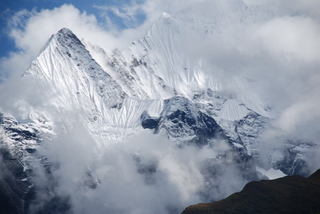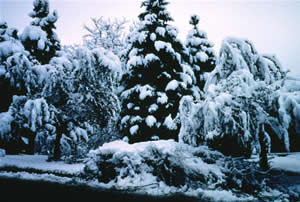
National Weather Service Forecast Office of Cheyenne, WY/ Ben Jacquot
Blizzards
Fast winds blowing up to 75 mph (120 kph), 43 inches (1 meter) of snowfall, power outages, and roofs collapsed due to the weight of the snow were all part of the Blizzard of 1993 that hit the entire East Coast of the United States. A blizzard or a severe snowstorm can cause a multitude of impacts.
Generally a blizzard is defined by the National Weather Service as a storm with large amounts of snow or blowing snow, winds greater than 35 mph (56 kph), and visibility of less than ¼ mile (0.4 km) for at least three hours. Some blizzards do not have snow falling at all. Instead, snow that had fallen previously blows at such a rate that it creates an effect similar to falling snow or large drifts of snow. This is called a ground blizzard.
Blizzard conditions usually build up on the northwestern side of a powerful storm system. The strong winds are from the difference in pressures between two systems; this means the difference in the low pressure system which is causing the stormy weather and the high pressure system to the west of the low.
The word blizzard was first used in the United States during the 1870’s when a snowstorm in Iowa was described as a blizzard in a newspaper. This word caught on and has been used throughout the United States and England ever since.
Blizzards are most common in the United States, particularly the upper Midwest and the Great Plains according to the National Weather Service. Blizzards are common in Canada and Russia as well. In Russia, blizzards are called "purgas". While the areas mentioned are the most common, blizzards can occur all over the world. Iran experienced a blizzard in January of 2008 where the temperatures reached -11ºF (-24ºC), and record snowfalls were recorded. Places near the equator can experience blizzards especially at high altitudes.
Blizzard conditions can be severe. Automobile travel becomes dangerous when blowing snow causes whiteout conditions and everything looks white and indistinguishable. Roads can be partially or fully blocked by drifts of snow that have been caused by the blowing snow. Many times cold temperatures, below freezing, are also part of blizzard conditions. A cold temperature combined with high winds can lead to low wind chill values. Low wind chill values can cause hypothermia or frostbite.












